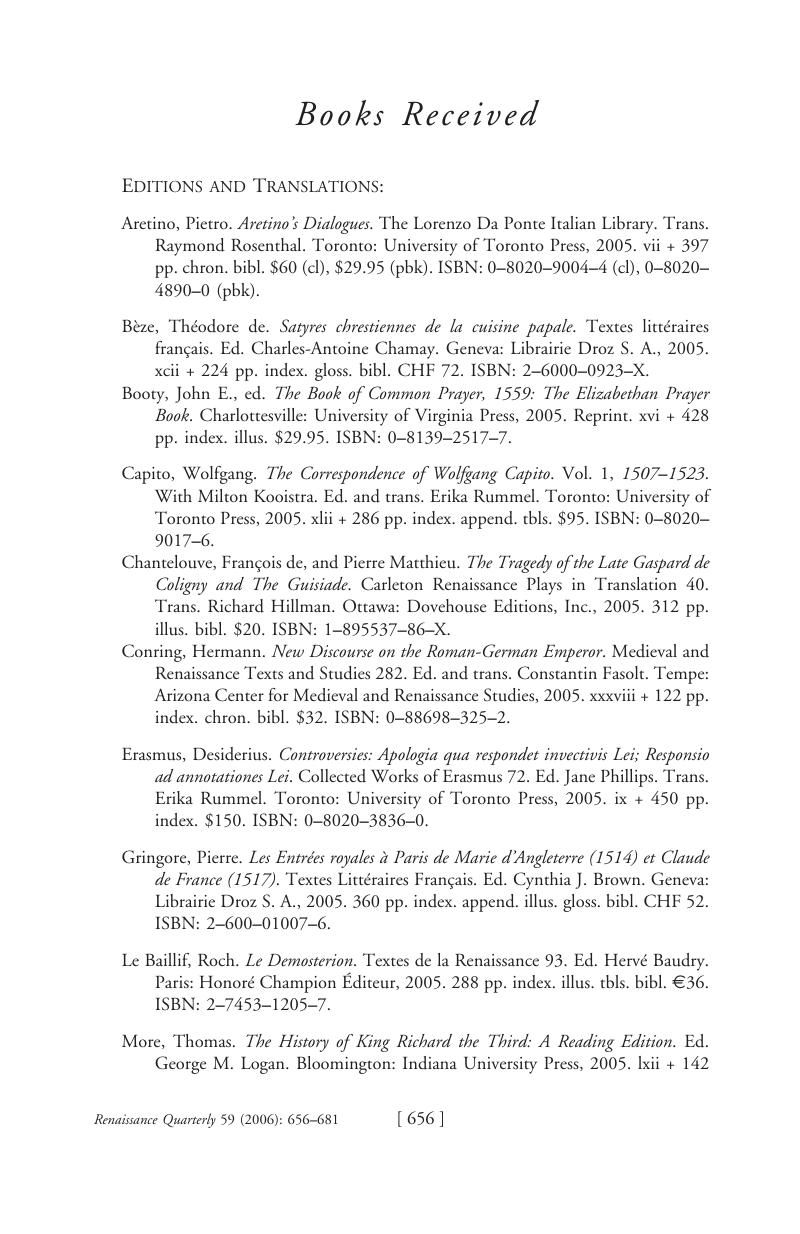Francesco, Tateo, and ,
Cavalluzzi, Raffaele, eds.
Forme e contesti: Studi in onore di Vitilio Masiello.
Bari:
Editori Laterza,
2005.
vi + 800 pp. append. illus. €30. ISBN:
88-420-7755-0.
Includes: Francesco Tateo, “Prefazione”; Isabella Nuovo, “‘Philosophia magistra vitae’: La missione del
sophós nelle
Epistole”; Francseco Tateo, “‘Coloro che a ben far puoser gl’ingegni: Elogio o ironia in
Inferno XVI?”; Raffaele Girardi, “‘Auctor in fabula’: Appunti sul Patrarca apologista”; Mauro de Nichilo, “Dal carteggio del Pontano: Due lettere di Alamanno Rinuccini”; Isabella Nuovo, “‘Philosophia magistra vitae’: La missione del
sophós nelle
Epistole di Antonio Galateo”; Domenico Defilippis, “‘Moneo tamen vos ut libellum lectitetis’: La dedica del
De his quae ab optimis principibus agenda sunt di Agostino Nifo”; Raffaele Ruggiero, “Guicciardini davanti alla
Res publica Romana: Le
Considerazioni intorno al ‘Discorsi’ del Machiavelli”; Grazia Distaso, “Metamorfosi di un mito: Una ‘curiosa’
Medea del primo Seicento”; Davide Canfora, “Ragion di Stato, pace e guerre di religione: Un’orazione del romano Gabriele Cesarini a Enrico IV di Borbone”; Mimma Pasculli Ferrara, “Il chiostro della chiesa di S. Caterina di Alessandria a Galatina e le storie francescane di fra’ Giuseppe da Gravina (1696): un programma iconografico tra letteratura e arte”; Renata Cotrone, “Alessandro Verri e
Le avventure di Saffo: anatomia di una passione”; Pierfranco Moliterni, “Mozart in analisi:
Idomeneo e Ginguené ‘le piccinniste’”; Anna Clara Bova, “Note su demitizzazione e poesia nell’Arcadia”; Giovanna Scianatico, “L’evoluzione di Calcante: Figure del clero nel teatro neoclassico”; Antonietta Acciani, “Il narratore e la creatura”; Domenico Cofano, “Il confronto Cesari-Manzoni: Testimonianze inedite di Raffaello Fornaciari”; Mariella Basile Bonsante, “I percorsi ‘turistici’ di De Nittis a Londra:
Trafalgar Square nella collezione Devanna”; Luigi Marseglia, “La via del romanzo nella rivolta dei ‘perduti’:
Il Gazzettino di Milano (1867–1868)”; Wanda De Nunzio-Schilardi, “Il premio Nobel negato alla ‘forte descrittrice della societ à’: Considerazioni in margine al carteggio Serao-Torraca”; Raffaele Cavalluzzi, “Nel ‘romanzo’ pasco-liano: le visioni, la morte”; Giovanni Attolini, “Profilo di un grande attore: Tommaso Salvini (1829–1915)”; Bruno Brunetti, “La ‘figura’ e il desiderio:
Bestie di Federigo Tozzi”; Bartolo Anglani, “Gramsci, un ‘classico’ del Novecento”; Giuseppe Bonifacino, “Allegorie pirandelliane:
Enrico IV: il tempo e la maschera”; Angiola Ferraris, “L’altro Corazzini”; Pasquale Guaragnella, “Icone della mente: Su un viaggio pugliese di Giuseppe Ungaretti”; Arcangelo Leone de Castris, “Il secondo Marinetti e la politica culturale del fascismo”; Ferdinando Pappalardo, “La rovina dell’angelo: Appunti per un saggio sui
Mottetti di Eugenio Montale”; Natàlia Vacante, “Il fantasma del padre e la memoria:
Voce giunta con le folaghe di Eugenio Montale”; Mario Sechi, “Tra nazionalismo e fascismo: Un capitolo trascurato della critica alfieriana del Novecento”; Pasquale Voza, “Bestia da stile: Pasolini e la lunga agonia del doppio”; Pietro Sisto, “La
Favola delle api tra finzione letteraria e impegno ideologico”; Danielle Maria Pegorari, “La neo-dialettalità nella storiografia letteraria”; and Lea Durante, “Ermanno Rea e la ‘dissolvenza ’ dei professori.”
Google Scholar 